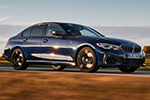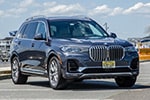Founded in 1916, BMW was originally a manufacturer of aircraft engines, and by 1928, the company had started developing automobiles. Since that time, it has grown to become one of the most recognizable brands, not just in the automotive industry, but in the world. Today, a leading manufacturer of premium cars and SUVs, the BMW name is synonymous with performance and luxury. Here are a few of the questions we hear most often.
What does BMW stand for?
BMW stands for Bavarian Motor Works.
Where is the BMW headquarters located?
The BMW headquarters is located in Munich, Bavaria, Germany
When did the iconic Kidney Grille appear on a BMW?
The iconic Kidney Grille was first featured on the BMW 303.
When was the BMW Roundel launched?
On July 21st, 1917, Rapp-Motorenwerke is renamed Bayerische Motoren Werke GmbH and the BMW Roundel is born. Since then, all products of the BMW brand have proudly displayed this trademark badge of honor.
When did BMW introduced their first motorcycle?
Developed on the drawing board in 1922, the first BMW R32 motorcycle causes a sensation when unveiled at the Berlin Exhibition in 1923. To improve air cooling, Chief Engineer Max Fritz positioned the flat twin engine crosswise in a double-tube frame and transmitted its power via a drive shaft directly to the wheel.
When did BMW AG Produce its first automobile?
A year after BMW AG bought the Eisenach automobile plant the company produces its first automobile, the Dixi.
Which model put BMW on the map?
BMW further developed its offerings of sport sedans, when it introduced the first two-door models in 1966. Two years later, the larger 2.0-liter four-cylinder engine was fited to the this lightweight sedan and the 2002 was born. The 2002 is often credited as the model which put BMW on the map in the US.
When was the first BMW built in the United States?
BMW vehicle production expands to a new plant in Spartanburg, SC. In March 1996, the first modern BMW roadster built in the U.S. – the Z3 – is delivered.
What’s the story behind the BMW logo?
This first BMW badge, which was registered in the German Imperial Register of Trademarks, retained the round shape of the old Rapp logo. The outer ring of the symbol was now bounded by two gold lines and bore the letters BMW.
The company’s home state of Bavaria was also to be represented on the company logo. The quarters of the inner circle on the BMW badge display the state colors of the State of Bavaria – white and blue. But they are in the inverse order (at least as far as heraldic rules are concerned, where you read clockwise from the top left). The reason for this inverse order of blue and white in the BMW logo was the local trademark law at the time, which forbade the use of state coats of arms or other symbols of sovereignty on commercial logos.
When did BMW launch their M division?
In the mid-eighties, BMW launched its M (Motorsport) Division, which created high-performance versions of BMWs road cars. The very first was the original M5, based on the E28 designated 5 Series. The M Division then went on to make the legendary E30 M3, which is famous for its near-perfect driving dynamics.
What is the Hofmeister Kink?
The Hofmeister Kink is a small inward kink at the base of the C-Pillar. As the C-Pillar slopes back towards the trunk of the car, right before it would normally end, it kinks back inward.
Named after BMW design director, Wilhelm Hofmeister, the famous Kink first debuted on the 1961 BMW 1500, which was part of the “Neue Klasse” of BMW vehicles.
Which BMWs have three rows?
The BMW X7 features standard three-row seating for up to seven passengers. The BMW X5 has an optional third row also.









































